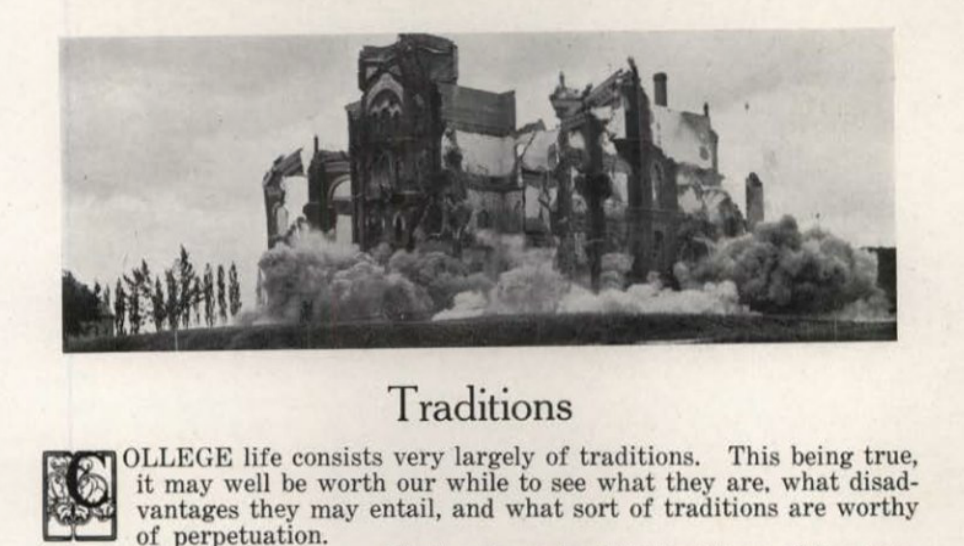2016-04-15

University of Idaho: 100 years ago
An impassioned argument in favor of college traditions. From the 1916 Gem of the Mountains Digital Yearbook.
College life consists very largely of traditions. This being true, it may well be worth our while to see what they are, what disadvantages they may entail, and what sort of traditions are worthy of perpetuation.
Traditions are human. We do not speak of the traditions of the stars, nor of the mountains, nor of the flowers, nor of the beasts, permanent and unchanging as all these, in the ordinary sense, may be and are. They can acquire traditions only in their relations to man, for traditions are the opinions, practices, and customs handed down from one generation to another.
Traditions are oral. They are communicated almost solely by word of mouth. We do not in general sit down and write them out for posterity. Rather, because of their intrinsic interest or value we tell them to our associates and they in turn pass them on to others.
Traditions are an evolution. We do not say, “Go to now, let us make some traditions.” Instead, they come into being of themselves, and then, with the years, develop into some measure of usefulness or else are cast aside. A merely local or temporary occurrence or state of feeling may possibly grow into a tradition, but only when it is based upon some human trait which is universal and permanent.
Taken collectively, traditions really constitute what we call conservatism. Thus, since the universities are said to be the very bulwarks of conservatism, we are naturally led to a consideration of our own traditions. Are we wisely keeping only that which is best in the old, which minds alert for the possibly better new? For custom may become a tyrant. Lord Bacon says, “A forward retention of custom is as turbulent a thing as an innovation; and they that reverence too much old times are but a scorn to the new.” And the poet Cowper:
“The slaves of custom and established mode,
With pack-horse constancy we keep the road,
Crooked or straight, through quags or thorny dells,
True to the jingling of our leaders’ bells.”
Are we, in a young university like Idaho, in such danger? We are, so long as we tolerate any “opinion, custom, or practice” which in itself is indefensible, merely because of a mistaken loyalty to tradition. One hesitates to single out for unfavorable mention any such bad tradition, lest he be accused of disloyalty or crabbedness. It may be safer, then, to mention a former Idaho tradition such as hazing, now happily extinct, or at least in its death-throes. At Idaho, fortunately, as in all the older, larger universities, it is no longer considered a crime to be one of the University’s newest guests or members. No longer is personal liberty interfered with. (The donning of the green cap I can regard only as a picturesque, sensible tradition promoting class unity and by no means in the category of hazing customs.)
But what shall we say of tolerated “sneaks,” be they of the classroom, examination, managerial, picnic, “bust,” or dance variety? Are they not excrescences upon the fair vine of our growth, too unlovely for retention and fit only for the inexorable shears of public condemnation? Let us comfort ourselves with Darwin’s words: “After the lapse of time, under changing conditions of life, if any part becomes to be injurious, it will be modified; or if it be not so, the being will become extinct as myriads have become extinct.”
But enough of the darker side of college traditions, for as a rule I believe them to be wholesome, enlivening, and highly valuable as contributing to that genuine sentiment - not sentimentality - which should envelop our academic life. Too long have we regarded sheer intellect as the highest part of our natures. Highest it may be, - farthest from the earth, - but not the deepest, not even the most important part of our lives. Our feelings come earlier, last longer, and occupy far more of our conscious existence than do our thoughts.
College traditions are like the ivy that covers the walls of brick, the green grass that rests the eye upon an August day, the pines that soften the colors and lines of the jagged hills. Too much intellectuality here at Idaho? Of course not - doubtless too little. But with the dignity, the atmosphere, the beauty of age and the real traditions of age we are all too scantily furnished. These are the things that bring the smile to the eyes of the reminiscent alumnus; that draw him back to his Alma Mater in memory and, whenever possible, in person; that mold alike student and teacher as they are in turn are shaping, be it ever so little, the figure and destiny of their university home. These are assets not to be laid before the coldly appraising eye of taxpayer or legislator, but none the less actual because intangible.
J.G. Eldridge